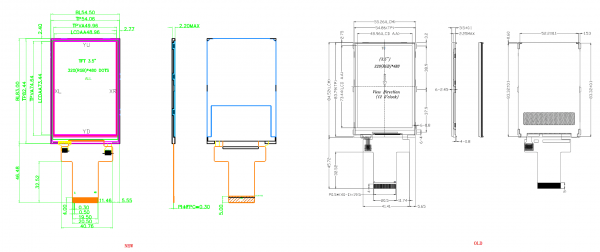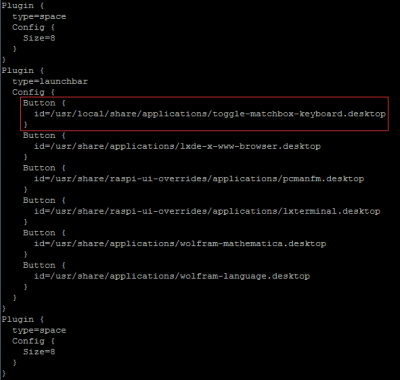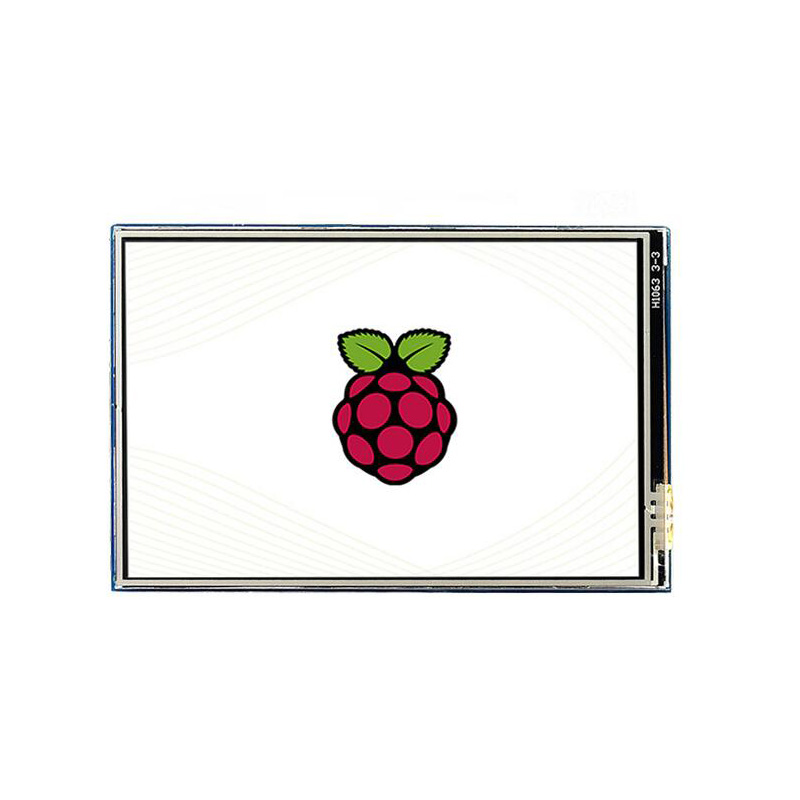- sales/support
Google Chat: zj734465502@gmail.com
- sales
+86-0755-88291180
- sales01
sales@spotpear.com
- sales02
dragon_manager@163.com
- support
tech-support@spotpear.com
- CEO-Complaints
zhoujie@spotpear.com
- sales/support
WhatsApp:13246739196
Raspberry Pi 3.5inch RPi LCD (B) User Guide
Introduction
3.5 inch Touch Screen TFT LCD Designed for Raspberry Pi
Version Update
- Because of stop production of old LCD, we update 3.5inch RPi LCD (B) to Rev2.0
- The dimension of LCD is different, and driver is updated as well.(Please download the new driver if you have the new version)
- You can recognize new and old version by the silk screen printing on the backside. The new version has screen printing Rev2.0

- The dimension of LCD are as below, left one is the new version. (download and open it if it is unclear on Wiki)

Getting Started
The RPi LCD can be driven in two ways: Method 1. install driver to your Raspbian OS. Method 2. use the Ready-to-use image file of which LCD driver was pre-installed.
Method 1. Driver installation
1. Download the lasted image from Raspberry Pi website and write it to SD card.
2. Connect RPi LCD to Raspberry Pi and connect Pi to networking.
3. Configure your Pi:
sudo raspi-config
Set as:
- Select Expand Filesystem.
- Boot Option -> Desktop Autologin (may differ depending on Raspbian revision)
3.Open Terminal of Raspberry Pi (You may need to connect an keyboard and HDMI LCD to Pi for driver installing)
git clone https://github.com/waveshare/LCD-show.git cd LCD-show/
Note: Net work connection is required while installing driver to your Pi, or else the touch won't work properly. #If the LCD you have is old version, use this command:
./LCD35B-show
#If the LCD you have is V2 version, use this command:
./LCD35B-show-V2
3. After system rebooting, the RPi LCD is ready to use.
Method 2. Using Ready-to-use image
The image file with pre-installed driver is located in the IMAGE directory of the CD, or you can download it from #Image. Extract the .7z file and you will get an .img file. Write the image to your micro SD card (How to write an image to a micro SD card for your Pi? See RPi Image Installation Guides for more details). Then insert the card to your Pi, power up and enjoy it.
Toggle between LCD and HDMI display
Once this LCD is enabled, meanwhile the default settings for HDMI are changed. If you want to use another HDMI monitor, please run the following command:
cd LCD-show/ ./LCD-hdmi
This toggles the mode to LCD display: #If the LCD you have is old version, use this command:
./LCD35B-show
#If the LCD you have is V2 version, use this command:
./LCD35B-show-V2
Screen orientation settings
After touch driver installed, the screen orientation can be set by these commands:
- 0 degree rotation
cd LCD-show #if old version, use this command: ./LCD35B-show 0 #if new version, use this command: ./LCD35B-show-V2 0
- 90 degree rotation
cd LCD-show/ #if old version, use this command: ./LCD35B-show 90 #if new version, use this command: ./LCD35B-show-V2 90
- 180 degree rotation
cd LCD-show/ #if old version, use this command: ./LCD35B-show 180 #if new version, use this command: ./LCD35B-show-V2 180
- 270 degree rotation
cd LCD-show/ #if old version, use this command: ./LCD35B-show 270 #if new version, use this command: ./LCD35B-show-V2 270
Touch screen calibration
This LCD can be calibrated using a program called xinput_calibrator which is pre-installed on the CD image. However, it was not pre-installed on original Raspbian OS. So in this case, you should get and install the program manually with
sudo apt-get install -y xinput-calibrator
Enter the following commands for touch screen calibration:
sudo DISPLAY=:0.0 xinput_calibrator
or select Menu -> Preferences -> Calibrate Touchscreen.
After running these commands, there will be a prompt for four-point calibration shown in the LCD screen. Click the points one by one to finish the touch calibration. Then, the new calibration data will be displayed in the terminal, as shows below. Please get these data for future use.
Doing dynamic recalibration: Setting new calibration data: 3919, 208, 236, 3913
Enter the following command to edit 99-calibration.conf:
sudo nano /etc/X11/xorg.conf.d/99-calibration.conf
Then, the old calibration data will be displayed in the terminal:
Section "InputClass" Identifier "calibration" MatchProduct "ADS7846 Touchscreen" Option "Calibration" "160 3723 3896 181" Option "SwapAxes" "1" EndSection
Modify the calibration data to the new calibration data displayed above):
Section "InputClass" Identifier "calibration" MatchProduct "ADS7846 Touchscreen" Option "Calibration" "3919 208 236 3913" Option "SwapAxes" "1" EndSection
Press the keys Ctrl+X, and select the option Y to save the modification.
The modification will be valid after rebooting the system. Enter the following command for system reboot:
sudo reboot
Notices: In case of inaccurate touch, please perform screen calibration again and reboot the system.
Install Virtual Keyabord
1. Install matchbox-keyboard
sudo apt-get install update sudo apt-get install matchbox-keyboard sudo nano /usr/bin/toggle-matchbox-keyboard.sh
2. Copy the statements below to toggle-matchbox-keyboard.sh and save.
#!/bin/bash #This script toggle the virtual keyboard PID=`pidof matchbox-keyboard` if [ ! -e $PID ]; then killall matchbox-keyboard else matchbox-keyboard -s 50 extended& fi
3. Execute the commands:
sudo chmod +x /usr/bin/toggle-matchbox-keyboard.sh sudo mkdir /usr/local/share/applications sudo nano /usr/local/share/applications/toggle-matchbox-keyboard.desktop
4. Copy the statements to toggle-matchbox-keyboard.desktop and save.
[Desktop Entry] Name=Toggle Matchbox Keyboard Comment=Toggle Matchbox Keyboard` Exec=toggle-matchbox-keyboard.sh Type=Application Icon=matchbox-keyboard.png Categories=Panel;Utility;MB X-MB-INPUT-MECHANSIM=True
5. Execute commands as below. Note that you need to use "Pi " user permission instead of root to execute this command
nano ~/.config/lxpanel/LXDE-pi/panels/panel
6. Find the statement which is similar to below: (It maybe different in different version)
Plugin {
type = launchbar
Config {
Button {
id=lxde-screenlock.desktop
}
Button {
id=lxde-logout.desktop
}
}
7. Append these statements to add an button option:
Button {
id=/usr/local/share/applications/toggle-matchbox-keyboard.desktop
}

8. reboot your Raspberry Pi. If the virtual keyboard is installed correctly, you can find that there is a keyboard icon on the left of the bar
sudo reboot
How to work with a camera
1. Select "Enable Camera" -> "<YES>"
sudo raspi-config
2. Copy the Camera driver to the OS of Pi then:
unzip camera.zip cd camera sudo chmod 777 Camera sudo cp update\ camera/95-stmpe.rules /etc/udev/rules.d/
3. Create a file called wheezy.list.
sudo nano /etc/apt/sources.list.d/wheezy.list
Append:
deb http://archive.raspbian.org/raspbian wheezy main
Exit with save.
4. Create a file called 10defaultRelease.
sudo nano /etc/apt/apt.conf.d/10defaultRelease
Append:
APT::Default-release \"stable";
Exit with save.
5. Create a file called libsdl.
sudo nano /etc/apt/preferences.d/libsdl
Append:
Package: libsdl1.2debian Pin: release n=jessie Pin-Priority: -10 Package: libsdl1.2debian Pin: release n=wheezy Pin-Priority: 900
Exit with save.
6. Last, execute the commands:
sudo apt-get update sudo apt-get -y --force-yes install libsdl1.2debian/wheezy sudo apt-get install evtest tslib libts-bin xinput sudo apt-get install python-pip sudo apt-get install python2.7-dev sudo pip install picamera==1.10 sudo reboot sudo TSLIB_FBDEVICE=/dev/fb1 TSLIB_TSDEVICE=/dev/input/touchscreen ts_calibrate
Camera will be enabled by the steps above.




